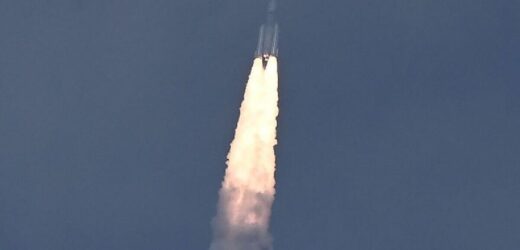UAE Space Agency release observations of Mars’ moon, Deimos
A rocket bound for the Moon blasted off from Indian soil on Friday in an historic first.
The Chandrayaan-3 rocket successfully launched from a spaceport in Andhra Pradesh in an event that could see India become just the fourth country to ever achieve a “soft-launch” on the Moon.
Thousands of spectators watched on in awe and erupted in applause as the space vehicle embarked on its journey, which should take 15 to 20 days to enter the Moon’s orbit if things go smoothly.
Indian Space Research Organization’s engineers and scientists also celebrated from mission control at Satish Dhawan Space Center after monitoring the launch of the spacecraft.
Chandrayaan-3, the word for “moon craft” in Sanskrit, took off from a launch pad in Sriharikota in southern India with an orbiter, a lander and a rover, in a major showcase of India’s most prized space technology.
It is set to land on the moon’s surface in late August and marks a “new chapter in India’s space odyssey”.
Prime Minister Narendra Modi hailed the Chandrayaan-3 as a”remarkable mission” bringing “the hopes and dreams of our nation”.
He added in a tweet: “July 14, 2023 will always be etched in golden letters as far as India’s space sector is concerned.”
Dr. Jitendra Singh, junior minister for Science and Technology, said the six-wheeled lander and rover module of Chandrayaan-3 is configured with payloads that would provide data to the scientific community on the properties of lunar soil and rocks, including chemical and elemental compositions.
The main objective of the mission is a safe and soft landing on the moon, according to ISRO director Sreedhara Panicker Somanath.
He said the Indian space agency has perfected the art of reaching up to the Moon, “but it is the landing that the agency is working on”.
It comes after India’s previous attempt to land a robotic spacecraft near the Moon’s little-explored south pole failed in 2019.
The objective of the $140-million mission was to study permanently shadowed craters believed to contain water deposits that were confirmed by India’s Chandrayaan-1 mission in 2008.
But Indian scientists have not let the failed attempt slow them down too much.
In fact, the nation also has plans to launch a first mission to the International Space Station next year, in collaboration with the United States as part of agreements between Modi and President Biden at the White House last month.
It will involve a one-off visit by an Indian astronaut to the International Space Station.
India also plans to launch one of its own astronauts from home soil in a domestically-made rocket in late 2024, according to Pallava Bagla, a science writer and co-author of books on India’s space exploration.
He said the Chandrayaan-3 mission is a “very critical” piece of India’s burgeoning space program.
As of April, India has launched 424 satellites for 34 countries, including Israel, the United Arab Emirates, Kazakhstan, the Netherlands, Belgium and Germany. The ISRO has earned approximately 1.1 billion rupees ($13.4 million) in the past five years from the launch of foreign satellites, the minister told India’s Parliament in December.
Follow our social media accounts here on facebook.com/ExpressUSNews and @expressusnews
We use your sign-up to provide content in ways you’ve consented to and to improve our understanding of you. This may include adverts from us and 3rd parties based on our understanding. You can unsubscribe at any time. More info
Source: Read Full Article



